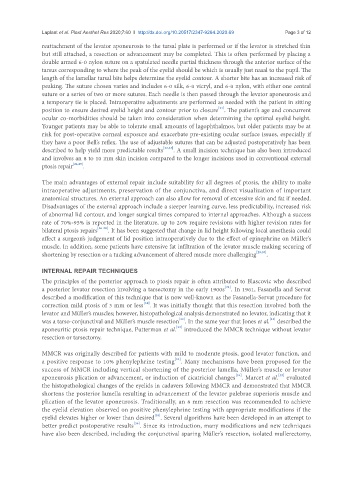Page 703 - Read Online
P. 703
Laplant et al. Plast Aesthet Res 2020;7:60 I http://dx.doi.org/10.20517/2347-9264.2020.69 Page 3 of 12
reattachment of the levator aponeurosis to the tarsal plate is performed or if the levator is stretched thin
but still attached, a resection or advancement may be completed. This is often performed by placing a
double armed 6-0 nylon suture on a spatulated needle partial thickness through the anterior surface of the
tarsus corresponding to where the peak of the eyelid should be which is usually just nasal to the pupil. The
length of the lamellar tarsal bite helps determine the eyelid contour. A shorter bite has an increased risk of
peaking. The suture chosen varies and includes 6-0 silk, 6-0 vicryl, and 6-0 nylon, with either one central
suture or a series of two or more sutures. Each needle is then passed through the levator aponeurosis and
a temporary tie is placed. Intraoperative adjustments are performed as needed with the patient in sitting
[21]
position to ensure desired eyelid height and contour prior to closure . The patient’s age and concurrent
ocular co-morbidities should be taken into consideration when determining the optimal eyelid height.
Younger patients may be able to tolerate small amounts of lagophthalmos, but older patients may be at
risk for post-operative corneal exposure and exacerbate pre-existing ocular surface issues, especially if
they have a poor Bell’s reflex. The use of adjustable sutures that can be adjusted postoperatively has been
described to help yield more predictable results [22,23] . A small incision technique has also been introduced
and involves an 8 to 10 mm skin incision compared to the longer incisions used in conventional external
ptosis repair [24,25] .
The main advantages of external repair include suitability for all degrees of ptosis, the ability to make
intraoperative adjustments, preservation of the conjunctiva, and direct visualization of important
anatomical structures. An external approach can also allow for removal of excessive skin and fat if needed.
Disadvantages of the external approach include a steeper learning curve, less predictability, increased risk
of abnormal lid contour, and longer surgical times compared to internal approaches. Although a success
rate of 70%-95% is reported in the literature, up to 20% require revisions with higher revision rates for
bilateral ptosis repairs [26-28] . It has been suggested that change in lid height following local anesthesia could
affect a surgeon’s judgement of lid position intraoperatively due to the effect of epinephrine on Müller’s
muscle. In addition, some patients have extensive fat infiltration of the levator muscle making securing of
shortening by resection or a tucking advancement of altered muscle more challenging [29,30] .
INTERNAL REPAIR TECHNIQUES
The principles of the posterior approach to ptosis repair is often attributed to Blascovic who described
[31]
a posterior levator resection involving a tarsectomy in the early 1900s . In 1961, Fasanella and Servat
described a modification of this technique that is now well-known as the Fasanella-Servat procedure for
[32]
correction mild ptosis of 3 mm or less . It was initially thought that this resection involved both the
levator and Müller’s muscles; however, histopathological analysis demonstrated no levator, indicating that it
[13]
was a tarso-conjunctival and Müller’s muscle resection . In the same year that Jones et al. described the
[32]
[33]
aponeuritic ptosis repair technique, Putterman et al. introduced the MMCR technique without levator
resection or tarsectomy.
MMCR was originally described for patients with mild to moderate ptosis, good levator function, and
[33]
a positive response to 10% phenylephrine testing . Many mechanisms have been proposed for the
success of MMCR including vertical shortening of the posterior lamella, Müller’s muscle or levator
[35]
[34]
aponeurosis plication or advancement, or induction of cicatricial changes . Marcet et al. evaluated
the histopathological changes of the eyelids in cadavers following MMCR and demonstrated that MMCR
shortens the posterior lamella resulting in advancement of the levator palebrae superioris muscle and
plication of the levator aponeurosis. Traditionally, an 8 mm resection was recommended to achieve
the eyelid elevation observed on positive phenylephrine testing with appropriate modifications if the
eyelid elevates higher or lower than desired . Several algorithms have been developed in an attempt to
[33]
[36]
better predict postoperative results . Since its introduction, many modifications and new techniques
have also been described, including the conjunctival sparing Müller’s resection, isolated mullerectomy,

